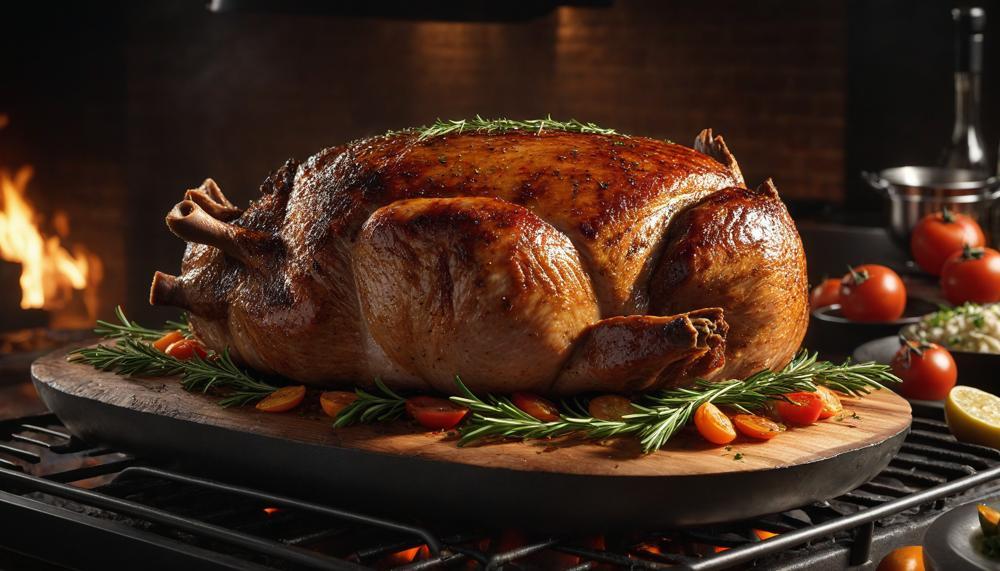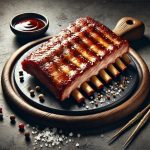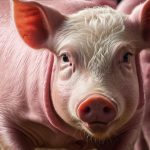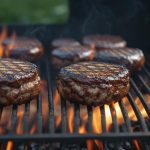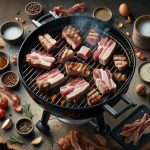Do you often serve pork roasts that are dry and tasteless? Have you been trying to decide whether to cook your roast with the fat facing up or down? You don’t need to look any further; we have all the answers here.
This blog post will talk about the long-running argument about whether the fat side should be up or down when cooking a pork roast. Our team of cooking pros has done a lot of study and testing to find the best way to always make a juicy and flavorful pork roast.
Get ready to elevate your skills in preparing a delicious pork roast by taking note of these key points:
- The significant role that fat plays in cooking a pork roast
- Advantages and disadvantages of cooking with either the fat side up or down
- Our recommended technique for achieving a perfectly cooked pork roast
- Tips and tricks for enhancing flavor and moisture
- Common mistakes to avoid when roasting a pork loin
Whether you are a seasoned cook or just starting out in the kitchen, this post is for anyone seeking to elevate their pork roast game. So put on your apron and prepare to amaze your family and friends with the ultimate pork roast.
Contents
The Quick Answer
When preparing a pork roast, it is essential to position the meat with the layer of fat facing upwards. This allows the fat to seep into the meat as it cooks, adding succulence and taste to the final dish.
For ease of reference, please refer to the following table:
| Cooking Method | Position of Fat Cap |
| Oven Roasting | Upwards |
| Braising/Slow Cooking | Downwards |
It is crucial to mention that keeping the fat cap intact is highly recommended for optimal results. Removing it may result in a dry and less flavorful pork roast. Additionally, while roasting, it is advisable to periodically baste the pork with the melted fat for additional moisture and flavor.
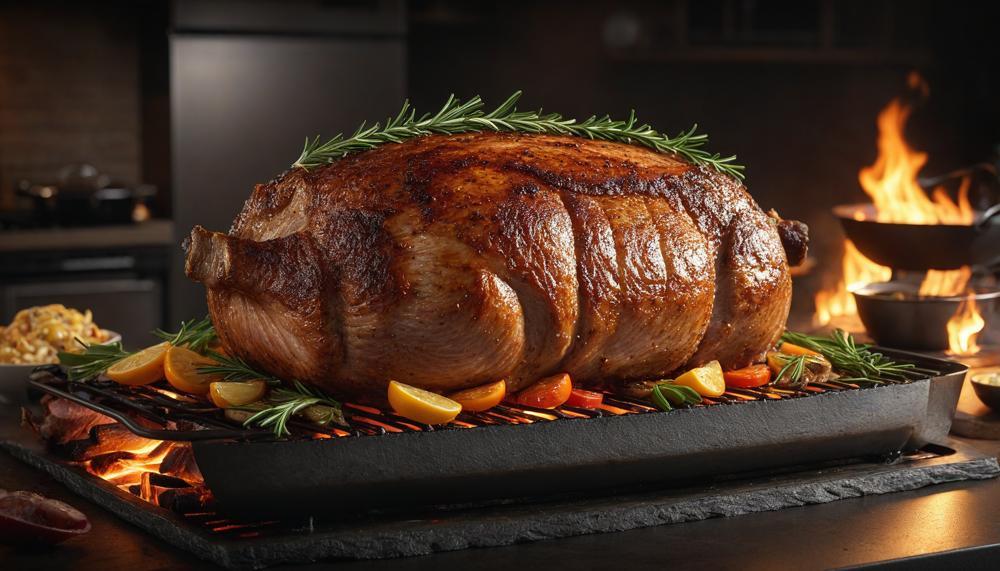
To determine if the pork roast is cooked to perfection, it is highly recommended to use a meat thermometer instead of relying on time or weight. For braised pork roasts or other slow cooking methods, it is also recommended to sear all sides of the meat before braising for enhanced flavor. However, braising times may vary depending on weight and temperature; thus, it is best to cook until fork-tender rather than relying on time.
Overall, proper usage of the fat cap guarantees a delectable pork roast regardless of the cooking method used.
The Importance of the Fat Cap
The fat cap is a crucial component in cooking a pork roast, playing a significant role in both enhancing flavor and preserving the meat’s tenderness.
Here, we will delve into the importance of the fat cap and its impact on the cooking process.
Flavor-Boosting Fat Cap
The fat cap on a pork roast is composed of a layer of fat that surrounds the meat.
While cooking, this fat renders and melts, imparting mouth-watering flavors to the meat. As it drips onto the meat, it infuses it with savory notes, elevating the taste of the pork roast.
Protection Against Burning
One of the primary reasons why the fat cap is essential in pork roast preparation is its ability to safeguard the meat from burning.
When placed on top of the heat source, it acts as a shield between the heat and the meat, preventing charring and allowing for better temperature control.
Moisture-Preserving Fat Cap
Aside from protecting against burning, the fat cap also helps retain moisture in the pork roast.
As mentioned earlier, the fat melts during cooking and bastes the meat, keeping it juicy and tender. This self-basting technique ensures that your pork roast remains succulent and flavorful.
Balancing Flavors and Temperature Control
Some experts suggest flipping the pork roast midway through cooking to achieve a balance between having the fat cap up or down.
This method allows for both self-basting and temperature regulation, but it may require more effort and affect temperature control.
Fat Side Up for Roasting
When roasting a pork roast, it is essential to cook it with the fat side up. This allows the fat layer to baste the meat as it cooks, resulting in a more flavorful and tender roast. The fat also acts as a protective layer, preventing the meat from drying out and burning.
In addition, cooking with the fat side up promotes better heat distribution throughout the roast, leading to a more evenly cooked and delicious end result.
There are several reasons why cooking with the fat side up is crucial:
- Infusion of flavor: As the fat melts off during cooking, it drips down into the roast, adding flavor and moisture to the meat. This results in a more succulent and tasty final product.
- Retention of moisture: The layer of fat on top of the roast serves as a barrier, preventing moisture from escaping while the meat cooks. This helps to keep the inside of the roast juicy and tender.
- Balance of temperature: The fat layer on top of the roast helps to distribute heat evenly throughout the meat. This means that both the top and bottom of the roast will cook at a similar rate, resulting in a more evenly cooked and flavorful end result.
- Protection against burning: The fat layer acts as a protective shield against high temperatures, preventing the meat from burning or becoming too dry during cooking.
To summarize, cooking a pork roast with the fat side up is incredibly important for achieving a delicious and tender end result. Not only does it add flavor and moisture to the meat, but it also helps to protect against burning and promotes even heat distribution.
Here’s a table outlining the advantages of cooking with the fat side up:
| Advantages | Description |
| Flavor infusion | The melting fat bastes the meat, adding flavor and moisture. |
| Moisture retention | The layer of fat acts as a barrier, preventing the meat from drying out. |
| Temperature balance | The fat helps to distribute heat evenly throughout the roast, resulting in an evenly cooked final product. |
| Protection against burning | The fat layer acts as a shield against high temperatures, preventing the meat from burning or becoming too dry. |
Fat Side Down for Braising
Position of the fat is one of the things you should think about when braising a pork roast. Traditional ways say to cook with the fat side down, but flipping the meat over halfway through cooking can also be helpful.
Common practice is to cook with the fat side down because it keeps the meat from burning or charring when it comes in contact with too much heat. This is very important when cooking over high heat, like when you grill or roast. Putting the fat cap down can also stop flare-ups and the smelly smoke that comes from fat dripping onto the heat source.
Self-basting is another good thing about cooking with the fat side down. So that the meat doesn’t get dry, the fat will melt and release, adding taste and moisture. This is very helpful when cooking slowly, like when braising in a Crock Pot. You can’t wash off the spices or sauces that are on top of the meat because of the layer of fat.
But if you flip the pork roast over halfway through cooking, you can get the best of both worlds. If you put the fat side down at first and then flip it over, you can get a crispy outside while still letting it bast itself and keep it from burning.
It really depends on the heat source whether you cook with the fat side up or down. It is best to put the fat cap down when grilling or slow cooking so that the meat stays safe from direct heat and doesn’t get too done. If you use a smoker, though, you might need to turn the pork roast over so that the fat cap is facing up so that it smokes properly and the flavors can soak in.
Conclusion
To sum up, learning how to use the fat cap is the key to making a juicy and delicious pork roast. Our team of culinary experts has done a lot of study and testing to find out whether cooking a pork roast with the fat side up or down is best.
We think that for baking, you should cook it with the fat side up and for braising, you should flip it over halfway through. This method makes sure that the flavors blend well, the moisture stays in, the temperature stays even, and there is no burning.
So, the next time you cook a pork roast, remember to put the fat side up for a delicious result that will please your family and show how good a cook you are. Say goodbye to lifeless pork roasts and hello to juicy, perfectly cooked meats.

